| « Prairie Grass Cafe Hosts Brunch with The Breakfast Queen, Ina Pinkney | Friday Foodporn: Bubble and Squeak » |
Beer Tue Mar 25 2014
When Brewers and Chefs Meet: A Love Story
Jesse Valenciana knew what he wanted his mole-inspired stout to taste like, but he was a cook and home brewer, not a professional brewmaster. The co-founder of ManBQue, the local men's grilling and social club, and recent author needed a brewer with the same depth of skills for manipulating flavors in beer as he could in the kitchen. To create his first craft beer collaboration, Valenciana called upon Clint Bautz, co-founder of the Northwest side Lake Effect Brewing Company.
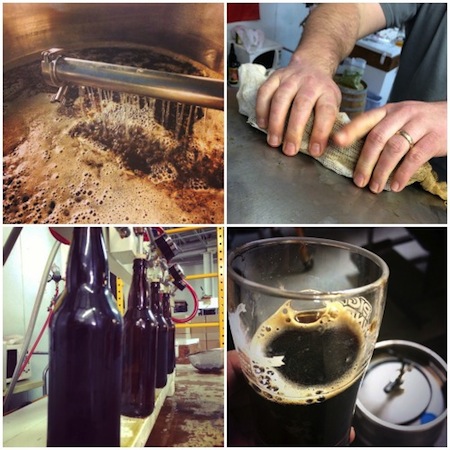
An avid fan of Bautz's work, Valenciana was unsatisfied with the mole stouts on the market, as they were not "authentic enough." Bautz, equally as passionate about food and someone familiar with working with chefs in beer making, jumped on board to create the Unholy Mole, a seasonal milk stout inspired by one of ManBQue's recipes, and infused with various roasted chilies. The beer made its debut at Dimo's Pizza in Bucktown and select taps around the city late last year and was so popular that the two men recently met again in the brewery to revive the recipe and bottle it for distribution.
Little did Valenciana know, however, that he and Bautz were contributing to the vanguard of one of the curious partnerships coming out of Chicago's exploding craft beer scene - the intersection where chefs and brewers meet. This time, however, it's more than just beer and food pairings.
To the Fountain You Head
Using food in beer isn't new to craft beer, but unlike most collaborations, which usually bring two brewers together, chef/brewer collaborations join two perspectives that have largely been polarized in the culinary spectrum.
If you're going to talk to anyone on chef/brewer collaborations in Chicago, you likely start with Cleetus Friedman, who has cranked out more than 30 craft beer collaborations with local brewers to date (with three more in the works). From Solemn Oath to Spiteful, Lake Effect, Pipeworks, Begyle, and Dark Horse...you name it, he's done it, and he continues doing monthly collaborations, his most recent with Stone Brewing, set to debut later this year.
I sat down with him at Fountainhead, where he serves as executive chef, to talk about chef/brewer collaborations, having already tried the ChocoTsuris, a porter collaboration with Solemn Oath that is Friedman's culinary love-child of German chocolate and Black Forest cake.
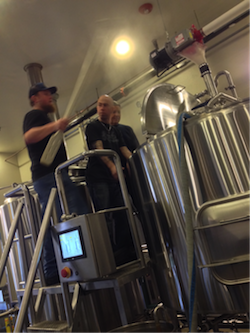
"Beer?" he asked me, a safe offer considering we'd be talking beer. I obliged, not one to turn down anything remotely boozy after the proper hour, the proper hour being anything past noon. He selected his Date, Sugar, Yeast, Magik collaboration with Pipeworks, a Belgian Dubbel that has since come and gone from the list, the crux of chef-collaborative small batch beers -- they last only as deep as the keg goes. (Fans rejoice: the barrel aged version is making an appearance this year.)
Anyone who's sat down with Friedman to talk beer and food can testify this is a subject that is near and dear to his heart. His interest in beer collaborations and the pairing of beer with food for one integrated experience started with his farm dinner series that he developed while at City Provisions, provoking him to pair up with local brewers.
"Beer and food go hand-in-hand," said Friedman. "It's the same attitude and a world of wanting to learn more. What better way to do that then to hook-up with someone that shares your values."
You could tell that for him, it was about maintaining integrity of the beer, of the story that would be writing itself in the beer history books. Community was a theme that rang loud throughout our brief talk, a word that has since become synonymous with craft beer and one that would follow me throughout my conversations.
"When you have a chef's influence into the beer, you introduce the culinary world and the two meld. Collaborating opens up your mind to the ideas of others -- it's like a ping-pong game between the chef and the brewer until something explodes and that's the gift. It's magic."
While Friedman may be tipping the scales on the frequency of collabs he does, plenty of chefs are jumping on the train as well, including Chef Kevin Hickey, former executive chef at Four Seasons and now bringing Michelin-starred fare to River North with the new Bottlefork.
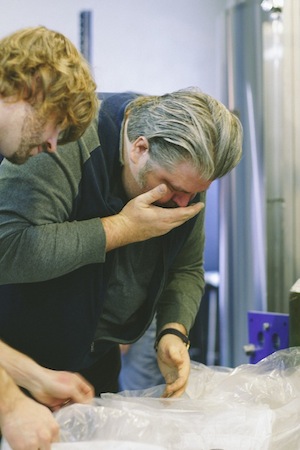
Hickey's collaboration history goes back to his first collaboration with former Goose Island brewmaster Jared Rouben, who approached him to collaborate on a beer for the opening of Allium. It was a lifelong love of beer that started as a teenager with The New World Guide to Beer and an interest in being closer to the product that led Hickey to say yes. Shortly thereafter, a quick tip about an upcoming community-supported brewery, Begyle Brewing, which Hickey referred to as "the most makeshift, ghetto-fied brewery I've seen, but they've since come a long way," was the start of a relationship that has produced more than five collaborations. The most recent one, the Root Cellar Rye Amber Ale, a mildly hoppy yet soft ale with an herbal nose of roasted malt, sugar beets, parsnips and celeriac root, is now available at Bottlefork.
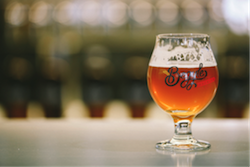
Hickey echoed Friedman when it came to talking about brewing from a chef's perspective, saying that brewers think about beer the way chefs think about food, which would make the partnership an obvious one. Beyond the similar thought process, Hickey also expressed the same sense of shared learning.
"As a food and beverage professional, I'm intrigued by everything related to what goes on the table. Brewing is so much like cooking, and my experience working with Begyle has hugely inspired me."
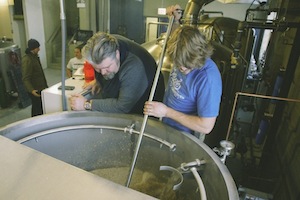
That inspiration translates when you sit down to try the Root Cellar Rye. What may look like a simple glass of beer becomes a journey when you learn that the root vegetables used in the brewing process were fed to a smoked pig that would later be served at the chef's table; or that the wort, the liquid extracted from the mashing process, much like steeped tea, was used to make the Root Cellar Wort cocktail, a mix of hot malt tea, bourbon and pistachio liqueur. It doesn't hurt that it tastes delicious.
Expect Hickey to continue seasonal collaborations at Bottlefork into the summer and with his upcoming Bridgeport concept, The Duck Inn, slated to open later this year.
Brewers like Bautz agree that shared inspiration has been beneficial. "For us, what I like about working with chefs is that is allows us to think outside of the box and to use ingredients we would never use. We can do something different and challenging and these new ingredients now become a part of our bag of tricks. At the end of the day, we both walk away from the process with something. It's a very creative, collaborative environment."
I would be remiss to write about chef/brewer collaborations without talking more about Rouben's contributions, as he is the brewer probably most well known for bringing chefs and beer together, having over 50 collaborations to date with the likes of Rick Bayless, Stephanie Izard and Paul Kahan and perhaps a symbol of the best of both worlds. Rouben started out at the Culinary Institute of America (CIA) before he was rerouted by the lure of beer, making his background in food the perfect match for a chef. With Moody Tongue Brewing, his independent departure from Goose Island, he is hoping to take brewing to the next level with his vision of culinary brewing, "a new genre that forges a connection between brewing and cooking."
"Outside of malt, hops, yeast and water, brewers are minimalists," said Rouben. "That said, they will continue to uphold their beers to high standards and so they are very interested in how to best use each additional ingredient to get the most out of it. There's a shared similar passion. To create something that tastes good. It's a seamless marriage.
And beer lovers, for better or for worse, may have chefs to thank for putting beer on the Chicago culinary map.
"It wasn't until places like Publican started bringing in a craft beer program and we started getting new wave bar concepts like Bangers & Lace that were backed by food-minded people that craft beer become part of the culinary conversation," said Michael Kiser, founder of Good Beer Hunting. "For a long time beer wasn't part of the culinary experience in chefs minds because it wasn't wine, but once chefs became attracted to the flavors and presentations of beer, they wanted to start working with it. I don't think they predicted the excitement that they would create."
From Stove to Bottle
Three months after my initial run in with Bautz and Valenciana at their first batch of the Unholy Mole, I was excited to hear that the beer had been brewed a second time; this time to be bottled. I met up with Valenciana in Pilsen at Nuevo Leon to try the second batch with an obvious food pairing, mole.
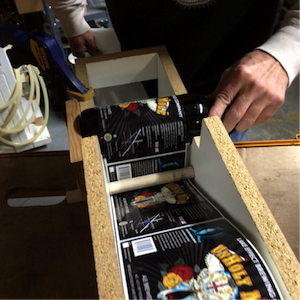 "We added two more chilies in this batch to be more true to the recipe," said Valenciana as he filled two clear solo cups in tribute to the movie Sideways (the scene where Miles drinks his prized '61 Cheval Blanc from a styrofoam cup in a diner). The beer poured thick and created a nice, slightly carbonated caramel head with substantial lacing (lacing is like legs to wine.) Valenciana instructed me to first take a sip of the beer then follow it with a bite of mole. "You will see that it will balance out the heat from the beer with the heat from the mole and they will come together in the back of your throat."
"We added two more chilies in this batch to be more true to the recipe," said Valenciana as he filled two clear solo cups in tribute to the movie Sideways (the scene where Miles drinks his prized '61 Cheval Blanc from a styrofoam cup in a diner). The beer poured thick and created a nice, slightly carbonated caramel head with substantial lacing (lacing is like legs to wine.) Valenciana instructed me to first take a sip of the beer then follow it with a bite of mole. "You will see that it will balance out the heat from the beer with the heat from the mole and they will come together in the back of your throat."
It first smelled of chocolate and roast with a mild hop and a hint of chili. I imagined myself in the middle of a 1980s-era Chicago kitchen, watching Valenciana's grandmother standing over a pot of stewing mole, where he had likely learned the recipe that would inspire him years later. The stout was chewy in texture; what was subtle on the nose wasn't in taste as the heat from the chilies popped, lightly painting my mouth with a whisper of novacaine. It was hoppy but not overly so, and when paired with the mole, the heat rounded out further followed by the balancing lactose. The third sip introduced the roast and smokiness from the malts. Like the perfectly balanced bite, it was a perfectly balanced sip.
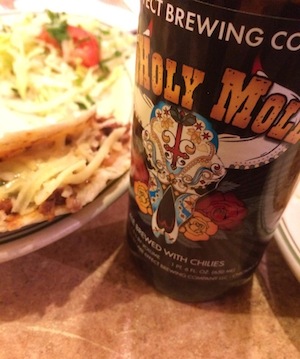
"I had a clear idea of the flavor profile that I was going for but Clint has beer-making down to a science," said Valenciana on his collaboration with Bautz. "He's a total food guy so we were on the same page, and he knew how to manipulate the ingredients to achieve what I was looking for. Sometimes your own knowledge hinders the process, but this type of collaboration brings two architects together -- the idea person (the chef) and the realist (the brewer). It's a perfect marriage, and you have to have that balance."
We are at a place where beer has cycled from pre-Prohibition craft beer to mass-marketed lagers, to the robust and hoppy IPAs that shifted so far to the left in distinction. Now, craft beer is returning to center, bringing with it chefs and a consideration to the overall food experience, finding a place at the table, and people want more of it. What started off as a love story has now turned into a marriage, a marriage of artist and chemist, idea-maker and realist, and the chef/brewer collaboration demonstrates that when two specialists come together over shared passion: culinary magic happens.
Kiser put the sentiment perfectly in Solemn Oath's "Keeping it Fresh": "There was a time when craft beer needed the spotlight - and it needed it all - in order to get the attention it deserved. But now that we've earned our place in America's heart, we can do so much more by drawing connections between beer and other like-minded culture creators like chefs and coffee roasters."
As for where it's going?
Said Rouben, "I believe what you will see next are brewers both adopting techniques from cooking and sourcing quality ingredients. Brewers will take a page out of the culinary cookbooks and both sides will begin to take information from one another."
And, while the beer may take center stage, the real story behind this is the community, camaraderie and the larger cultural influence that goes beyond the glass. As chefs move to craft beer, they provide it with the exposure it needs to reach others with its unique culture and help elevate it to where we have kept wine for so long, changing our food culture and changing the way we look at one of America's oldest contributions.
Every love story has a turning point, and the chef/brewer collaboration is another page in the evolving craft beer narrative.
To be continued.
Photo Credits: ManBQue, Lake Effect Brewing, Bottlefork, Cleetus Friedman








